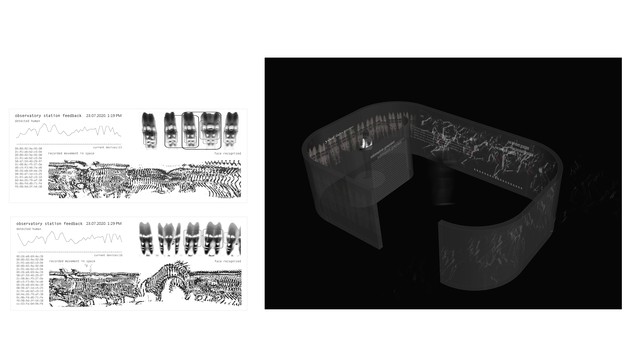OBSERVATION LAB 2020, Germany, Weimar
Pavilion of Tracking Sensations







Surveillance cameras monitor our movements and, as public, we are starting to accept intrusive measures- as if we were enjoying public surveillance. This pavilion aims to make a critique by creating an aesthetical representation of an invisible data collection, where visitors can be discovered and observed using methodologies of "tracking and watching systems". Visitors will leave their traces of movements in space and experience the possibilities of newly generated faces, with system that recognizes (or does not) their new identities, further exposing them by revealing exact MAC addresses of their mobile devices. As a memory, at the end of the tour, visitors will receive feedback of their movements and tracking results as receipt.
We collect and provide enormous amounts of data during our daily routines - through social platforms, surveillance cameras and sensors, internet... But what happens to all that data collected? How is it collected? Are we even aware of technologies that are writing codex of surveillance? During a pandemic outbreak, we started experimenting with low-tech devices and their possibilities of becoming surveillance-system gadgets. Using softwares such as Touchdesigner and Arduino NodeMCU on laptops we had in our homes, we dug into the world of face and body recognition language, and created our own response to widely spread trends of observation technologies. The initial references we interpreted for the development of conceptual solution are located as experiments in urbanism, psychology and technological achievements: William H. White's research "The Social Life of Small Urban Spaces", Wundt's and Helmholtz's experiments on morphology of movements and Harold Edgerton's visualizations of stroboscopic technology development. The working flow was structured through "bottom-up" approach, and was divided into "technological experiments" and "spatial creation", implicating unification of media and architecture. Through technological experiments we managed to program a software that is distorting faces, recognizing them, locating bodily movements in space and representing them as motion slits, "sniffing" devices which receive WiFi signal and revealing their MAC addresses. Architectural space (pavilion) is, on the other hand, driven by technological components that it needs to carry out, and is set as a clean and simple structure which helps the media in creation of space and atmosphere.
https://www.ksenijatajsic.com/observation-lab
https://www.uni-weimar.de/uploads/tx_showcase/Project_Booklet.pdf
Details
Team members : Didem Zeynep Ödemiş & Ksenija Tajsić
Supervisor : Dr. Reinhard König, Dr. Sabine Zierold, Stefan Kraus, Juan Carvajal B.
Institution : Bauhaus University Weimar
Descriptions
Technical Concept : The main technical concept can be structured as "usage of low-tech devices in achieving high-tech systems through bottom-up approach". This statement is also bringing specific visual qualities, and therefore could not be easily separated from "visual concepts". Technological sides of "distorting faces, recognizing them, locating bodily movements in space and representing them as motion slits" were programed visually in Touchdesigner software using the webcam and laptop. "Sniffing" WiFi devices and revealing their MAC addresses is generally a collage of knowledge we collected during hours of researching internet content on how we can do it just with Aduino and programming skills. Besides, technical components (such as number of projectors in the pavilion, position of cameras, lighting, etc.) are calculated and thought-through under professors' supervision during the semester.
Visual Concept : Visual concept is aesthetically relying on Muybridge's chronophotographic sequences and Davidhazy's peripheral photos, and can be explained as "creating a copy of the real world by converting it into data". Installation is collecting visual data from visitors, and creating a feeling of constant observation. The sequences of visitors' presence in the pavilion are recorded, and they can get a feedback paper (as a receipt) of data collected and made during their visit. Both visual and technical concepts are working synchronously and together (with spatial elements as well) all in order to create awareness on citizens digital rights in era of smart surveillance systems and how easily they could be re-interpreted with the regular and not invasive technology, leaving us in the position of rethinking our moves and acts.
Credits
Ksenija & Didem
Ksenija & Didem
Ksenija & Didem
Ksenija & Didem
Ksenija & Didem
Ksenija & Didem
Ksenija & Didem
Ksenija & Didem
Ksenija & Didem